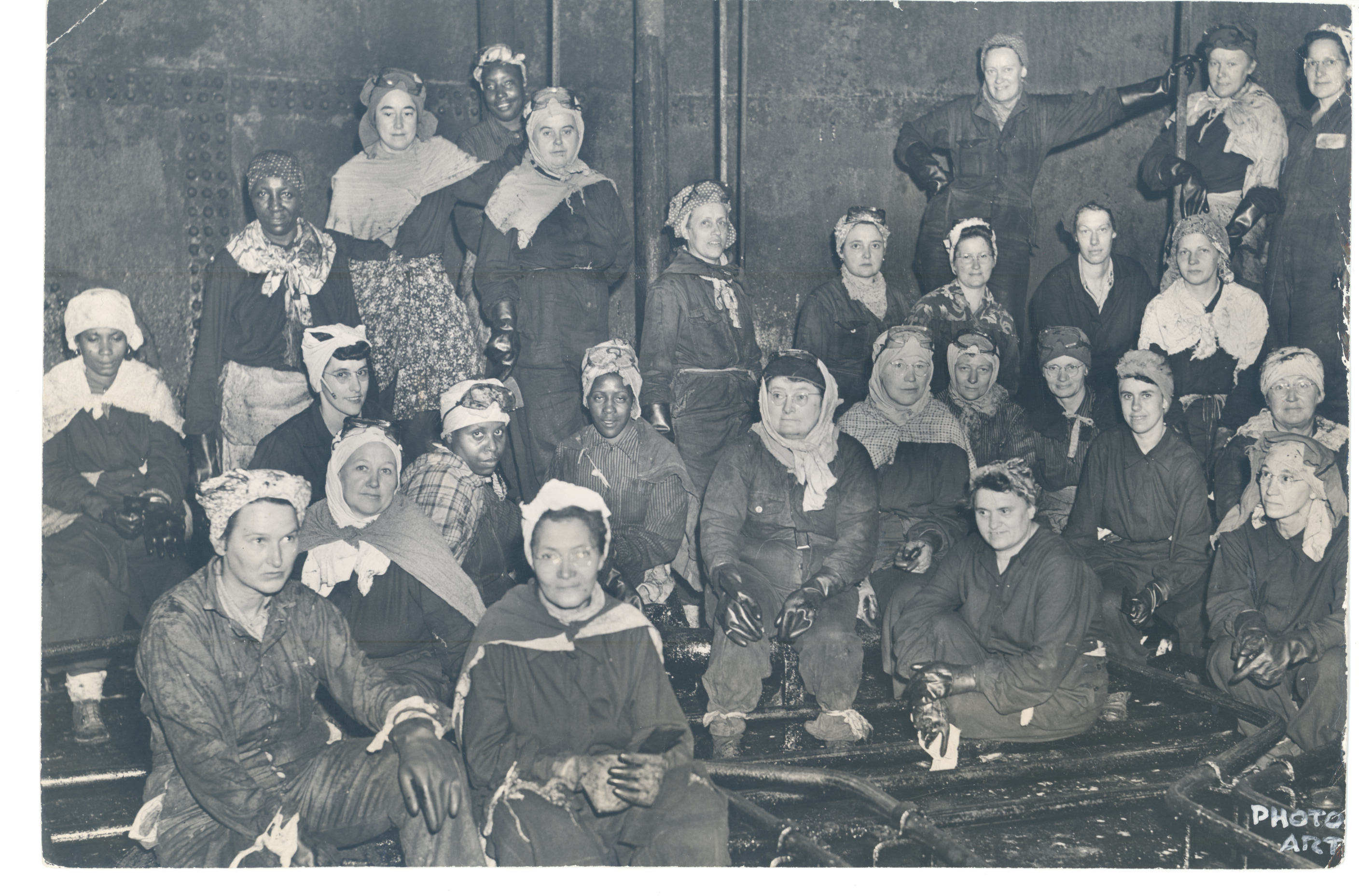Overview
Many women found their lives changed by World War II, which transformed the nation’s workforce. Thousands of women took wage-earning jobs for the first time, a national increase of 57 percent between 1941 and 1945. At the peak of the Boeing Company’s wartime production effort south of Seattle, 46 percent of its 50,000 employees were women. At the large Portland’s Kaiser shipyards in 1944, 28,000 women comprised 30 percent of the workforce, with countless others working in smaller yards along the Columbia and Willamette Rivers. To accommodate families with children, day-care centers became an important part of urban life for the first time.
The Kaiser shipyards made an early commitment to hire women to fill construction positions at its Portland and Vancouver facilities. When the Oregon Shipbuilding Company hired two women welders in April 1942, it was the first time a U.S. Maritime Commission yard employed female workers to carry out production functions. As news circulated about the shipyard’s willingness to hire women, welding schools began training more women for the work. By early 1943, all of the major shipyards operated trainee welding programs in an effort to meet the labor shortage. Sociologist Karen Skold points out that the yards hired women at an earlier time and in greater numbers than elsewhere in the nation, a reflection of the region’s dire labor shortage. Women shipyard employees earned good wages and received equal pay with men for the same kind of work. Read the full essay here
Content Standards
- HS.55 Analyze the complexity of the interaction of multiple perspectives to investigate causes and effects of significant events in the development of world, U.S., and Oregon history.
- HS.58 Examine and evaluate the origins of fundamental political debates and how conflict, compromise, and cooperation have shaped unity and diversity in world, U.S., and Oregon history.
- HS.59 Analyze ideas critical to the development of social, labor, and political movements in history
- HS.66 Examine and analyze the multiple perspectives and contributions of ethnic and religious groups, as well as traditionally marginalized groups within a dominant society and how different values and views shape Oregon, the United States, and the world.
- HS.67 Evaluate historical sources for perspective, limitations, accuracy, and historical context.
- HS.68 Select and analyze historical information, including contradictory evidence, from a variety of primary and secondary sources to support or reject a claim.
- HS.69 Create and defend a historical argument utilizing primary and secondary sources as evidence.
Additional Sources
Oregon Encyclopedia Entries
"Kaiser Shipyards," by Gordon Oliver
"Hazel Ying Lee," by Heather Burmeister
"Claire Maybelle Phillips," by Sig Unander
"Umatilla Army Depot," by Susan Badger Doyle
Articles, Books, and Blogs
Koehler, Pat. “Reminiscence: Pat Koehler on the Women Shipbuilders of World War II.” Oregon Historical Quarterly, v. 91, No. 3 (Fall 1990), pp. 285-291.
Linder, John. "Liberty Ships and Jim Crow Shipyards: Racial Discrimination in Kaiser's Portland Shipyards, 1940-1945." Oregon Historical Quarterly v.120, No. 4 (Winter 2019), pp. 518-543. Click here to download a free PDF of this article
Platt, Amy E. “Go into the yard as a worker, not as a woman”: Oregon Women During World War II, a Digital Exhibit on the Oregon History Project. Oregon Historical Quarterly, v. 116, No. 2 (Summer 2015), pp. 234-248.
Carpenter, Stephanie A. On the Farm Front: The Women’s Land Army in World War II. DeKalb: Northern Illinois University Press, 2003.
Kesselman, Amy. Fleeting Opportunities: Women Shipyard Workers in Portland and Vancouver during World War II and Reconversion. Albany: State University of New York, 1990.
Manson, Janet Marilyn. "Here's What Makes the 'Whistle' Toot": Kaiser's Bo's'n's Whistle Now Available on OHS Digital Collections. Oregon Historical Society Blog, April 23, 2020.
Simmons, Diane. "Rejection, Reception, and Rejection Again: Women in Oregon's World War II Shipyards." Oregon Historical Quarterly vol. 119, No. 1 (Spring 2019), pp. 96-119. Click here to download a free PDF of this article
Oregon Public Broadcasting Oregon Experience Documentaries
Online Exhibits
Women in the Shipyards, Oregon History Project
American Aviatrixes: Women with Wings, Digital Public Library of America
Additional Lesson Plans
World War II: Women on the Home Front: Digital Public Library of America Primary Source Sets
Cite
The OE Staff. Women, Labor, and World War II. 2021. Retrieved from The Oregon Encyclopedia, https://www.oregonencyclopedia.org/packets/7. (Accessed December 14, 2025.)Teacher Guide
After reading about and examining all of the photos and documents included in this packet answer the following questions.
-
What kinds of jobs were available to women during World War II that typically were not available to them before the war? What jobs or positions were still not available to women during WWII?
-
How did women working in wartime jobs challenge gender stereotypes?
-
Read Beatrice Marshall's Oral History and examine the photo Native American women from Chemawa train to work in shipyards. How did women from Black, Hispanic, Asian, or Indigenous communities participate in the World War II labor force? Were they afforded the same jobs, wages, and benefits as their white counterparts?
-
Browse through pages of the Bo's'n's Whistle from August 19, 1943. Who do you think wrote the articles? Who was the audience? How are women portrayed in the pages? To view more editions of the Bo's'n's Whistle you can visit: "Here's What Makes the 'Whistle' Toot": Kaiser's Bo's'n's Whistle Now Available on OHS Digital Collections. or explore The Bo's'n's Whistle collection on the Oregon Historical Society's Digital Collections site.
-
Examine the following documents. The More Women at Work poster Handbook for New Women Shipyard Workers Child Service Centers drawing. How did the U.S government and wartime industries promote and support women entering the workforce? Are these programs still in place?
-
After the war, women were expected to return to being housewives or low-level workers. Why?
To help you answer all of these questions visit the Oregon History Project Digital Exhibit: Women in the Shipyards, where you will find additional primary sources including photos, memorabilia, newspaper clippings, and government documents.

